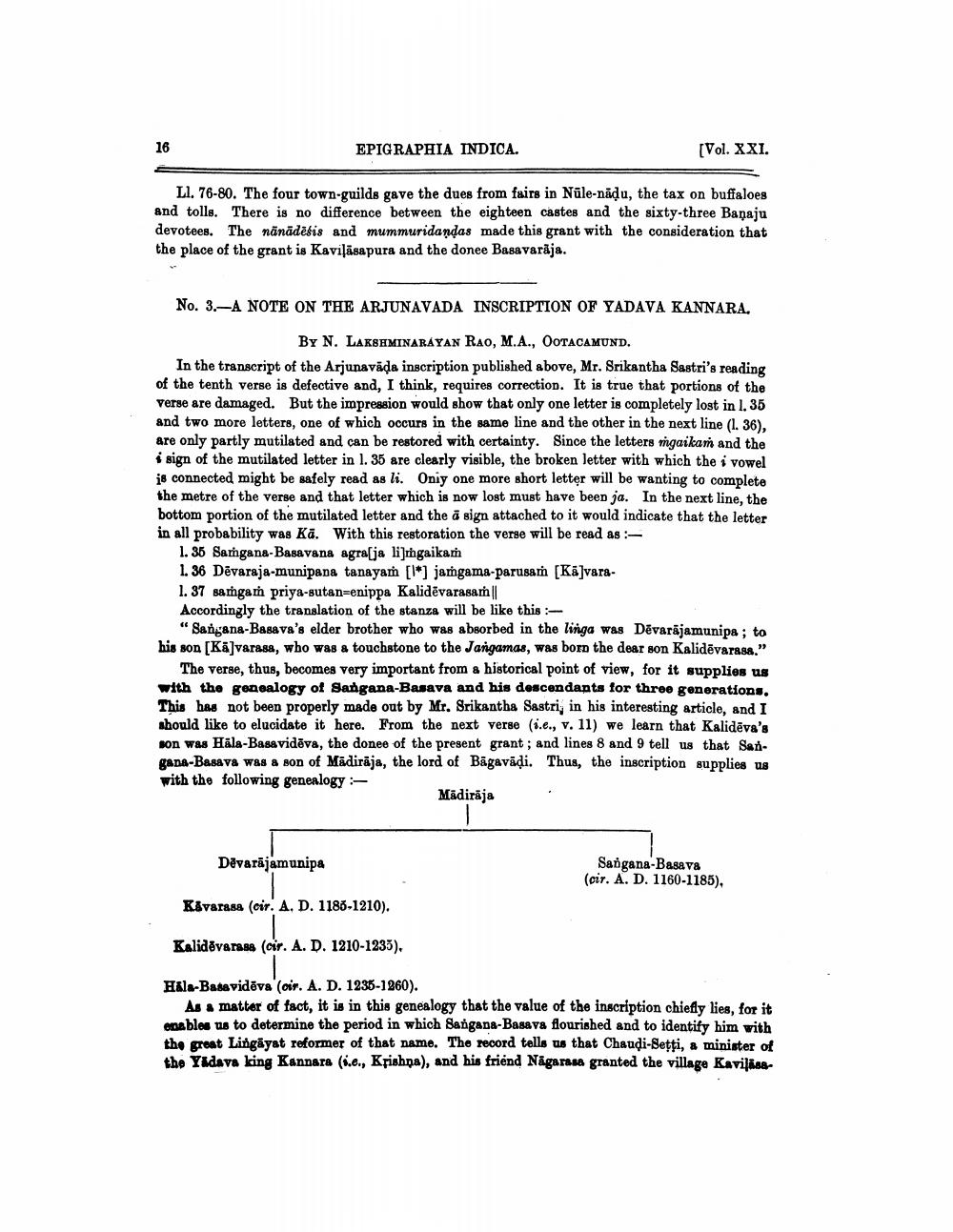________________
EPIGRAPHIA INDICA.
[Vol. XXI.
Ll. 76-80. The four town-guilds gave the dues from fairs in Nüle-nādu, the tax on buffaloes and tolls. There is no difference between the eighteen castes and the sixty-three Banaju devotees. The nänādesis and mummuridandas made this grant with the consideration that the place of the grant is Kavisāsapura and the donee Basavarāja.
No. 3.-A NOTE ON THE ARJUNAVADA INSCRIPTION OF YADAVA KANNARA.
By N. LAKSHMINARAYAN RAO, M.A., OOTACAMUND, In the transcript of the Arjunavāda inscription published above, Mr. Srikantha Sastri's reading of the tenth verse is defective and, I think, requires correction. It is true that portions of the verse are damaged. But the impression would show that only one letter is completely lost in 1. 35 and two more letters, one of which occurs in the same line and the other in the next line (1. 36), are only partly mutilated and can be restored with certainty. Since the letters mgaikam and the i sign of the mutilated letter in l. 35 are clearly visible, the broken letter with which the i vowel is connected might be safely read as li. Oniy one more short letter will be wanting to complete the metre of the verse and that letter which is now lost must have been ja. In the next line, the bottom portion of the mutilated letter and the ā sign attached to it would indicate that the letter in all probability was Kā. With this restoration the verse will be read as :
1. 35 Samgang-Basavana agrasja li]mgaikam 1.36 Dēvaraja-munipana tanayam [1] jamgama-parusar (Kä]vara1. 37 sathgam priya-sutan=enippa Kalidēvarasam || Accordingly the translation of the stanza will be like this:
"Sangana-Basava's elder brother who was absorbed in the linga was Dēvarājamunipa ; to his son [Kā]varasa, who was a touchstone to the Jangamas, was born the dear son Kalidēvarasa."
The verse, thus, becomes very important from a historical point of view, for it supplies us with the genealogy of Sangana-Basava and his descendants for three generations, This has not been properly made out by Mr. Srikantha Sastri, in his interesting article, and I should like to elucidate it here. From the next verse (i.e., v. 11) we learn that Kalidēva's son was Häla-Bassvidēva, the donee of the present grant; and lines 8 and 9 tell us that Sangana-Basava W&& son of Mâdirāja, the lord of Bāgavādi. Thus, the inscription supplies us with the following genealogy -
Mădirāja
Dévarājamunipa
Sangana-Basava (cir. A. D. 1160-1185),
Kävarass (cit. A. D. 1186-1210).
Kaliddvarass (cir. A. D. 1210-1235).
Hila-Basavidēva (oir. A. D. 1235-1860).
As a matter of fact, it is in this genealogy that the value of the inscription chiefly lies, for it enables us to determine the period in which Sangana-Basava flourished and to identify him with the great Lingayat reformer of that name. The record tells us that Chaudi-Setti, a minister of the Yadava king Kandara (.e., Krishna), and his friend Nagarasa granted the village Kavilhas




